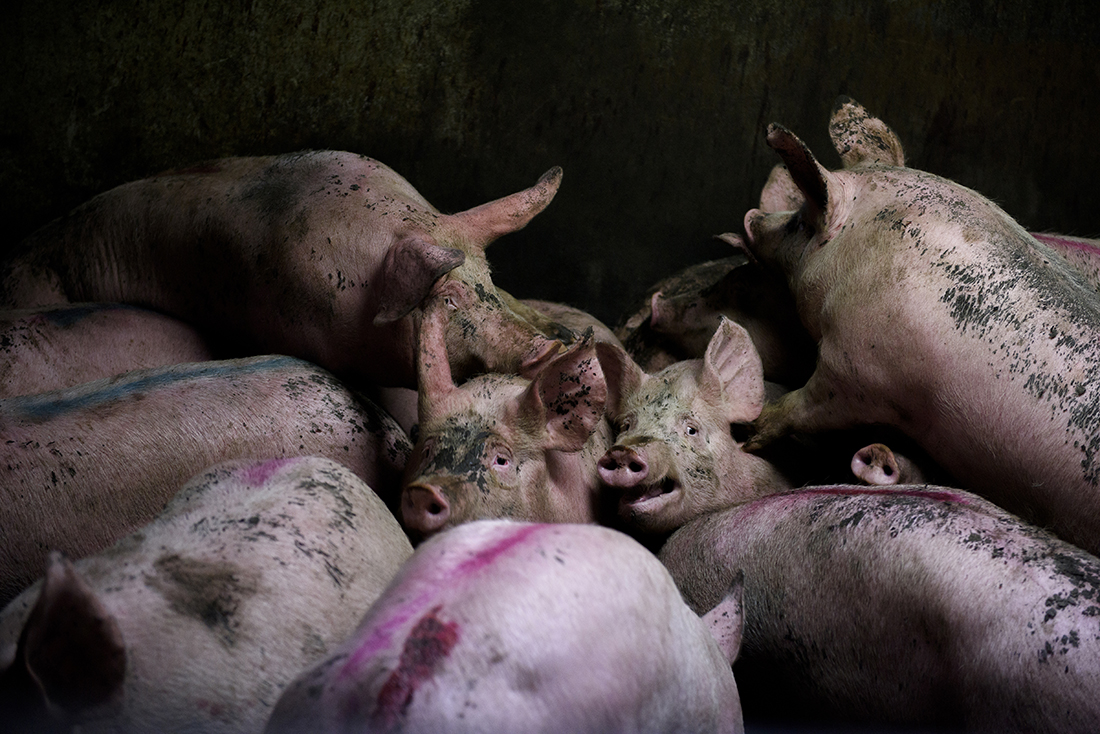Daily Life - 3RD PLACE WINNER: Aitor Garmendia
Aitor Garmendia
Slaughterhouse
Support this photographer - share this work on Facebook.
Over the course of a number of months, between the years 2015 and 2017 I gained access to 58 slaughterhouses, located ten different Mexican states. During this time, I documented the killing of cows, goats, chickens and horses, as well as the transport of these animals, from farm to slaughterhouse.
The work presented below, has as its objective to make visible the exploitation and systematic violence inflicted upon animals in slaughterhouses; treatment which is deliberately hidden from the public by the meat industry. With this investigation, I hope to contribute to the current debate, both social and political, surrounding speciesism and the anti-speciesist position promoted by the animal rights movement working towards the abolition of all animal exploitation.
Thanks to images which have been obtained by activists who have infiltrated farms and slaughterhouses, members of the public have been able to see the truth behind the animal agriculture industry; a side of the industry kept deliberately behind closed doors. These types of investigations are damaging the image of the meat production companies, influencing the demand for their products, closing down businesses and threatening the economic future of those companies that continue to exploit animals.
The meat industry is well aware of the social impact generated by the publication of images and footage obtained by activists within their facilities, and for this reason they do all that they can to guard against infiltration. To access a farm or slaughterhouse with a camera, and in particular with a camera which is not hidden or “undercover” is not easy and so many activists carrying out this work are forced to use hidden cameras – either concealed on their own bodies as they enter and move around the farms or slaughterhouses, or static hidden cameras which are fixed in a position by activists where they will not be found by the farm or slaughterhouse workers.
In the United States, decades of investigations and campaigns brought by activists against the industry have resulted in the agriculture lobby influencing politicians in order to protect their financial interest in animal exploitation from criticism. A number of states have now made it illegal to film within farms and slaughterhouses.
Slaughterhouses which permit entry to a photo journalist are exceptional cases and, in the rare case that this happens, it is usually forbidden for those photographers to capture the moment in which the animals are killed, that is to say: access to the kill floor is generally out of bounds. In addition, the industry profiles known individual activists and organisations to ensure that, for those connected with the movement to end animal exploitation, access to their facilities is prohibited or, at best, made as difficult as possible.
Mexico is one world’s largest producers of beef, chicken and pork meat. Despite this, until 2015, no large-scale, undercover of the countries slaughterhouses has ever been carried out.
At the end of 2015, after various failed attempts, I was able to enter two slaughterhouses in the Mexican state of Jalisco, and photograph their practices; from the arrival of the animals in the trucks to the moment of slaughter. This was the beginning of the investigation which has now extended to 58 Mexican slaughterhouses and which now encompasses a comprehensive account of what happens there behind closed doors. The project presented here represents that work, carried out over the course of several trips and several months.
It is important to underline that, although all of the material presented in this project has been collated in Mexico, the purpose of this project is not simply to demonstrate what happens in Mexican slaughterhouses specifically. While there are certain differences in the techniques employed, in the facilities themselves, in the existence of, enforcement of and compliance with any respective country’s laws – some stricter than others, some more lax than others – the fundamental practices and aims of any slaughterhouse, regardless of where it is in the world, is the same: kill as many animals as possible, as quickly as possible.
The cruelty and violence that exists in these places, the terror forced upon the animals in their final, miserable moments, is a common factor in all slaughterhouses and forms an intrinsic part of the industrial animal exploitation system and, as such, as is evidenced throughout the citations and references used throughout this project, this happens in every slaughterhouse in the world. Aside from the size of any individual slaughterhouse, the specific technique used to kill, or the legal framework within which the slaughterhouses operate in any particular country, these places represent one of the largest and most systematic form of violence against animals.
About author:
I have been involved in animal rights activism for years and I have documented many animal exploitation facilities. In the last three years I carry out a personal photojournalism project where I document different forms of animal exploitation in order to create a long-term essay on the exploitation and abuse suffered by animals and on the struggle that takes place in all the world to defend them.
The last work that I have carried out has been an investigation in more than fifty slaughterhouses in Mexico being the biggest research done in these places ever.
On many occasions and due to the secrecy of the animal exploitation industry I have to work with false identities.

